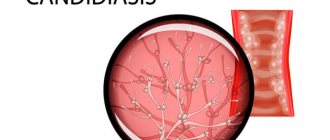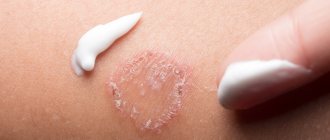Vulvovaginal candidiasis. Application of Zalain in clinical practice
We are talking, in particular, about vaginal dysbiosis. Despite the emergence of new methods of diagnosis, treatment and prevention of this condition, the frequency of vaginal dysbiosis continues to remain high, which affects the health and psycho-emotional sphere of a huge number of women [1–4]. One of the main reasons for the development of this condition is the increase in the number of immunodeficiency states, observed against the background of deteriorating environmental conditions, poor nutrition, frequent stress, and a pharmacological boom with the uncontrolled use of drugs, primarily antibiotics [5].
Most often, a genital infection that causes vaginal dysbiosis is caused by several pathogenic factors - viruses, bacteria, fungi, protozoa, which cause diseases that are similar in clinical course, but different in pathogenesis and treatment methods [1, 6, 7].
Vulvovaginal candidiasis is a prevalent infectious disease that affects the mucous membrane of the vulva and vagina in women of reproductive age. In recent years, the prevalence of candidiasis has been steadily increasing; the share of this disease in the structure of infectious lesions of the vulva and vagina is 30–45%. Vulvovaginal candidiasis ranks second among all vaginal infections and is one of the most common reasons for women to visit a gynecologist. In the USA and Europe, 13 million cases of this disease are registered annually [8, 9].
Etiology
An analysis of the medical literature in recent years indicates an increased interest in the problem of mycoses in general and vulvovaginal candidiasis in particular. Mycoses are a widespread group of infections that are caused by a large number of different types of pathogenic and opportunistic fungi [3, 10–13].
Mushrooms (lat. Fungi or Mycota) are a kingdom of living nature that unites eukaryotic organisms that combine some of the characteristics of both plants and animals.
Mycoses are an important problem in clinical medicine. From potential “diseases of the future,” mycoses have become actual “diseases of the present.” The causative agents of mycoses are numerous, and the diseases they cause in humans and animals are very diverse. The number of species of microscopic fungi (micromycetes) is estimated at approximately 100,000–200,000 species. Approximately 1,500 new species are described every year. About 100 species are currently of real importance in clinical practice [14].
Yeast-like fungi of the genus Candida belong to the family Cryptococcaceae. Currently, up to 200 species of fungi of the genus Candida are known. Of these, only C. albicans, C. glabrata, C. pseudotropicalis, C. tropicalis, C. krusei, C. parapsilosis, C. quillermondii and some others can cause diseases. Candida spp. - single-celled yeast microorganisms 6–10 microns in size.
Many Candida spp. dimorphic, forming pseudomycelium or mycelium. Worldwide, some Candida spp. detected by culture from the mucous membrane of the oral cavity and gastrointestinal tract in 30–50% of healthy people, from the mucous membrane of the genitals in 20–30% of healthy women. Therefore, it is important to distinguish between a disease (candidiasis) and colonization of the mucous membranes or skin, in which the use of antifungals is usually not required.
The source of the causative agent of invasive candidiasis is usually endogenous, since Candida spp. - natural inhabitants of human mucous membranes and skin [15].
The main role in the occurrence of vaginal candidiasis belongs to fungi of the genus Candida albicans, which are isolated in 95% of cases of this disease. They are the most pathogenic due to their high adhesive ability and the production of lytic enzymes that ensure their penetration into vaginal epithelial cells [16].
Risk factors for the development of vaginal candidiasis are:
- long-term and/or unsystematic use of antibiotics [17];
- pregnancy;
- use of oral contraceptives (especially those with a high estrogen content);
- the use of corticosteroids, cytostatics, radiation therapy;
- endocrine diseases (diabetes mellitus, ovarian dysfunction);
- development of immunodeficiency (severe infectious diseases, injuries, operations).
Factors predisposing to the development of the disease may be:
- wearing synthetic tight-fitting clothing;
- obesity;
- failure to comply with hygienic conditions;
- hot climate;
- use of hygiene products;
- consumption of yoghurts and foods with a high content of lactobacilli [18].
At the same time, the inconsistency of the data obtained regarding the listed risk factors for the development of vulvovaginal candidiasis is emphasized, which necessitates the need for additional research [19].
Features of the infection
The following stages are distinguished in the development of candidal infection:
1. Adhesion of fungi to the surface and colonization of the mucous membrane by fungi.
2. Invasion into the epithelium, overcoming the epithelial barrier of the mucous membrane, entering the connective tissue of the lamina propria, overcoming tissue and cellular protective mechanisms.
3. Penetration into blood vessels and hematogenous dissemination with damage to various organs and systems.
A significant increase in the number of cases of vulvovaginal candidiasis is due to the action of the predisposing factors described above. When prescribing broad-spectrum antibiotics, it is necessary to take into account that they suppress not only pathogenic bacteria, but also lactobacilli located in the vagina, which are physiological antagonists of yeast-like fungi (lactobacillus suppresses the attachment of Candida to epithelial cells and their reproduction). As a result of a shift in the pH of the vaginal contents to an alkaline environment, the process of self-cleaning of the vagina is disrupted. Additionally, Candida has the ability to use antibiotics as food sources. This creates favorable conditions for the active reproduction of Candida in the woman’s genitals [20].
It is customary to distinguish 3 clinical forms of vaginal candidiasis:
- candidiasis;
- acute form of vulvovaginal candidiasis;
- chronic (recurrent) vulvovaginal candidiasis.
Candida carriage is characterized by the absence of symptoms of the disease, but in a microbiological study in the vaginal discharge, yeast-like fungi of the genus Candida are present in small quantities (<104 CFU/ml). Asymptomatic carriage of Candida is observed in 15–20% of non-pregnant women of reproductive age.
The terminology of acute and chronic vulvovaginal candidiasis, implying only the frequency of relapses, simplifies the diagnosis, but at the same time, the classification of complicated and uncomplicated forms of the disease implies the type of pathogen, the severity of the disease, as well as the state of the macroorganism, which affects the choice of therapy [20 ].
According to some authors, the causes of recurrent vulvovaginal candidiasis are changes in local and cellular immunity at the level of the vaginal mucosa. Humoral and innate immunity are of less importance. T1- and T2-mediated cellular responses correlate with resistance and susceptibility to mucosal candidiasis. T1-type reactivity with the production of IL-2, ILN-g and IL-12 (stimulating macrophages and polymorphonuclear lymphocytes), as well as mucosal IgA, are the dominant reactions in the vagina. They support asymptomatic Candida colonization. T2-type reactivity with the formation of IL-4-6, IL-10, IgG, histamine and prostaglandin E2 predominates in cases where endogenous and exogenous factors lead to an increase in the number of C. albicans microorganisms. This response “turns off” T1-type defensive reactions and triggers immediate-type hypersensitivity reactions. Candida passes from the blastospore phase to the hyphal phase and epithelial invasion occurs [21].
Currently, the most modern classification of vaginal candidiasis is proposed by DA Eschenbach (Table 1) [22].
One of the main features of the course of vulvovaginal candidiasis is its frequent combination with opportunistic bacterial microflora, which has high enzymatic and lytic activity, which creates favorable conditions for the introduction of fungi into tissues [23].
Clinical manifestations of vulvovaginal candidiasis are: intense irritation and itching in the vagina; typical white cheesy discharge and burning in the external genital area when urinating and pain during intercourse.
In chronic recurrent disease, an exacerbation is often observed before the onset of menstruation [24].
Diagnosis of acute vulvovaginal candidiasis is not difficult - it is microscopy of pathological material (scrapings from the mucous membranes of the affected areas) and detection of budding yeast cells and/or pseudomycelium and mycelium of Candida spp. in native or Gram-stained preparations. In all cases, it is necessary to exclude sexually transmitted infections. A pH test can be used. If the cytological method of studying Candida spp. not detected (the sensitivity of the method is 65–70%), in the presence of characteristic clinical manifestations, a cultural study should be performed (inoculating material on specialized media) in order to detect colonies of Candida spp. In the case of acute candidiasis, these diagnostic measures are quite sufficient to make an etiological diagnosis. In case of chronic recurrent vulvovaginal candidiasis, species identification of the pathogen is necessary (in this form of the disease, the frequency of detection of Candida fungi not related to the species C. albicans is up to 20–25%) and determination of the sensitivity of the isolated fungal culture to antimycotic drugs [25–28].
You can also use molecular biological research methods (polymerase chain reaction) - detection of DNA of a certain type of yeast-like fungi, serological reactions - agglutination reaction (RA), complement fixation reaction (CFR), precipitation reaction, passive hemagglutination reaction. Of the complex of serological studies, the most significant is RSC with yeast antigens (1:10, 1:16). The diagnostic titer of RA for candidiasis is considered to be a serum dilution of more than 1:100 and an enzyme-linked immunosorbent assay - determination of IgE antibodies against C. albicans in vaginal lavages. The highest titer of IgE antibodies is to serotype A, which accounts for 83% of all C. albicans strains [29].
About 20–25% of women with negative bacteriological results have positive culture results for Candida within 30 days after treatment. This means that a small number of microorganisms remain persistent in the vagina, and this number is not enough to cause symptomatic vaginitis, but enough to lead to relapse of the disease when exposed to the listed trigger factors that stimulate excessive growth of fungi [30].
A direct relationship has been established between gestational age and the incidence of vaginal candidiasis, which during pregnancy is characterized by an asymptomatic course and frequent relapses. If fungi of the genus Candida are found in the vagina of 10–17% of non-pregnant women, then vaginal candidiasis in pregnant women occurs, according to various sources, in 30–40% of cases, reaching 44.4% before childbirth [31]. Such high rates are due to changes in hormonal balance during pregnancy [8].
Treatment
Modern pharmacology provides a large selection of antimycotic drugs, but the issue of treatment effectiveness today remains unresolved and does not lose its relevance. Refinement of old and development of new treatment regimens for vulvovaginal candidiasis are required.
Therapy depends on the clinical form of the disease. The main purpose of prescribing drugs with an adequate spectrum of action is to simultaneously act directly on the pathogen and possible systemic reservoirs of yeast-like fungi to eradicate the pathogen and exclude possible relapses [20].
Improving the treatment of vulvovaginal candidiasis is facilitated by sexual abstinence, the doctor’s explanation of the nature of the infection and methods of treatment, and the patient’s understanding that the disappearance of symptoms of the disease should be accompanied by microbiological sanitation [32].
The following main antimycotic drugs are currently used to treat vulvovaginal candidiasis:
- polyene series (natamycin, nystatin, levorin, amphotericin B);
- imidazole series (clotrimazole, ketoconazole, omoconazole, miconazole, bifonazole, etc.);
- triazole series (fluconazole, itraconazole);
- other drugs (griseofulvin, flucytosine, chloronitrophenol, dequalinium chloride, iodine preparations, etc.).
The following routes of administration of antifungal agents are distinguished:
- systemic (oral, intravenous, etc.);
- local (vaginal suppositories, tablets and globules, creams, solutions) [33].
Sertaconazole, registered for the first time in Russia (Fig. 1), in the form of vaginal suppositories with prolonged release of the drug containing 300 mg of the active substance, was produced by Laboratoires Théramex (Monaco) and marketed on the Russian market under a license from Ferrer Internacionale AS (Spain) by the Hungarian pharmaceutical plant EGIS under trade name Zalain. Zalain is an antifungal agent - a derivative of benzothiophene and imidazole - for topical use.
Zalain causes lysis of fungal cells. Also, the mechanism of action of this drug is associated with competitive antagonism with another component of the cell membrane - tryptophan. In therapeutic doses, the drug has fungicidal and fungistatic effects. When administered intravaginally, high levels of Zalain remain in the vagina for a long time and significantly exceed both the minimum inhibitory and fungicidal concentrations against C. albicans, C. glabrata and other fungi that do not belong to the genus Candida. There is no systemic absorption when used intravaginally. Zalain in unchanged form is not found either in urine or in blood plasma.
Zalain contains a fundamentally new component - benzothiophene, which provokes rupture of the plasma membrane of the fungal cell, which leads to its death, i.e., the fungicidal effect of the drug is ensured. Benzothiophene has a high lipophilicity, which enhances the penetration of the drug into the skin and its appendages. Thanks to this dual mechanism of action, the risk of relapse is minimal. No side effects or allergic reactions were observed in any woman when using Zalain.
Studies have shown that Zalain, a derivative of imidazole and benzothiophene, is an effective and safe treatment for acute vulvovaginal candidiasis. In addition to the pronounced antimycotic effect, the drug has a wide spectrum of action (including affecting nonspecific flora: Streptococcus spp., Staphylococcus spp., Proteus spp., Bacteroides spp., E. coli). The high clinical efficacy of Zalain (97.8%), short course of treatment, ease of use, low frequency of side effects, insignificant systemic effects, wide spectrum of action allow us to consider this drug promising in the treatment of acute vulvovaginal candidiasis, including in combination with nonspecific vaginitis, in non-pregnant and non-lactating women [33].
In the study of fungal strains isolated from vaginal contents, sensitivity tests were performed to various azoles, nystatin, amphotericin B and flucytosine. It turned out that sensitivity to Zalain was superior to that to other antimycotics, indicating greater activity of Zalain [35].
Considering that pregnancy is the main predisposing factor for the development of vulvovaginal candidiasis, its treatment for this condition poses a particular problem [36].
There are special requirements for drugs used in pregnant women. Along with high efficiency and minimal ability to induce the development of resistance in pathogens, they should be characterized by low embryotoxicity and good tolerability for the mother. Some antifungal drugs are contraindicated during pregnancy due to their teratogenic effect. In order to reduce the risk of developing undesirable systemic effects in the mother and fetus, the safest route during pregnancy is the intravaginal route of administration of antimycotics. In addition, with this method of administration, a reduction in clinical symptoms and recovery occur faster [12].
In this regard, a study was conducted in which it was found that Zalain is highly effective with a single treatment regimen in pregnant women. At the same time, its tolerability and ease of use allow us to consider this drug one of the most promising in the antifungal therapy of acute vulvovaginal candidiasis in women during pregnancy [37].
In conclusion, we can say that Zalain can be used to treat both acute and recurrent forms of vulvovaginal candidiasis, as well as in pregnant women.
ZALAIN (cream)
ova.
I purchased it from the pharmacy chain St. Petersburg Pharmacies, the cost of the ointment is 540 rubles per 20 gram tube. The ointment is packaged in a cardboard box with the name of the product and the manufacturer’s logo.
On the back of the box, the manufacturer described the composition of the ointment and recommendations for the period of use and storage of the cream. Below the manufacturer has provided all its contact information
On the side of the package there is information about the use of the ointment, and the manufacturer also indicated that the ointment is sold only in pharmacy chains and without a prescription.
The ointment is for external use only.
The ointment tube is made of soft aluminum. The name of the product and the manufacturer's logo are printed on the front surface of the cream tube.
On the back of the tube there is information about storing the product and the full name of the manufacturer. The tube has a white plastic screw cap.
The dispenser is not large. The cream is dosed by pressing on the tube, the cream consumption is economical. The cream itself is white in color with a very light, not dense consistency, not greasy, but more watery in structure. Smells like pharmaceutical medicine.
Inside the box was an insert with detailed information about the cream, its use and dosage. I used the cream on the wound twice a day, morning and evening. Before applying the cream, the wound was treated with hydrogen peroxide. At the hospital I was tested for fungus. Although I did not visit any public baths or swimming pools where it is possible to catch such a sore and did not use someone else’s shoes. The only thing was that my feet got wet several times and I had to stay in wet shoes for several hours. It’s only been two days since I used this miracle ointment, the wound on my leg instantly began to heal and almost healed. Tests showed that there was no fungus, which I’m not happy about. And the wound on the leg most likely appeared as a result of prolonged exposure to wet shoes. The ointment turned out to be very effective as a healing agent. I read reviews about it on the site, it is also used for women’s diseases and the effect is quick and positive, it also treats skin diseases. In a word, the ointment really has a productive and operative effect in treatment. I recommend purchasing Zalain cream from the pharmaceutical plant EGIS, but be sure to consult your doctor before using it. I rate the cream excellent for its versatility and quick effect in treatment. Thank you all for your attention to my review!) Be healthy! See you again!)








